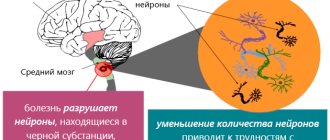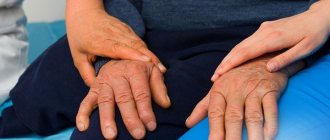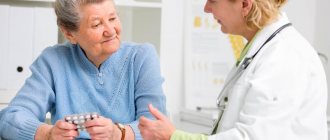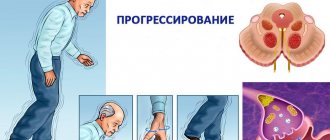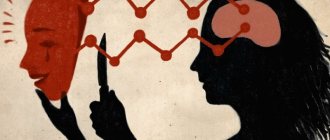Parkinson's disease is a serious disease of the nervous system that affects neuron cells in the brain. Parkinson's disease is progressive. From a medical point of view, it is manifested by motor disorders, namely, weak motor activity, limited movements, muscle mobility in a state of complete rest, tremors of the limbs. The disease is also accompanied by the development of mental disorders - a person’s mental abilities decrease, and the state of depression increases.
The causes of Parkinson's disease can be different; the disease cannot be treated. Only through drug therapy can the symptoms of Parkinson's disease be relieved.
Medical prescriptions include a structured lifestyle, as well as physical exercises for balance and stretching. Speech problems will be corrected by a speech therapist.
Stages of Parkinson's disease
As the number of cells in the cerebral cortex that produce the neurotransmitter dopamine decreases, Parkinson's disease progresses more and more actively. As a result, the functioning of those parts of the brain that control involuntary movements of the limbs decreases.
Based on the severity of the symptoms of the disease, parkinsonism is divided into several stages . Each stage is characterized by its own characteristics and specific treatment. The Hoehn-Yahru scale is used to differentiate the stages of Parkinson's disease. According to this scale, the following stages of the disease are distinguished:
- Zero – the person has no obvious signs of pathology.
- The first is that there are slight disturbances in the movements of the fingers and hands, trembling of some limbs, which stops in a state of sleep or rest, depression, lethargy appears, and sleep is disturbed.
- The second is that motor disturbances appear on both sides, facial expressions worsen, the functioning of the sweat glands worsens, and processes associated with sweat secretion are disrupted. A person performs his daily work, but his movements are already becoming slow.
- Third, the face takes the form of a mask; a person acquires a certain pose in which he begins to be constantly; this pose is called the pose of a supplicant; muscle tone and tension increases; motor activity becomes very low.
- Fourth – there are disturbances in coordination of movements when walking, a person’s ability to maintain balance in one position or another decreases, problems appear with the functioning of the vestibular apparatus, in everyday life a person needs help and support from outside. At this stage, signs of dementia may appear.
- Fifth - obvious signs of a nervous system disorder - a person cannot move, eat, or control urination without the help of others. A person at this stage completely needs the care of loved ones; the speech he pronounces is difficult to perceive and understand.
Motor signs
For a long time, it was believed in medical circles that the main symptoms of Parkinson's were exclusively motor signs. It was based on the totality of motor disorders that in the past the diagnosis of parkinsonism was made.
Impaired motor functions always first appear on one side of the body, and after 2-5 years it gradually spreads to the other half.
Asymmetry of the onset of the disease is the most accurate sign of the onset of Parkinson's disease in modern diagnostics.
Hypokinesia as a symptom
Hypokinesia as a symptom is expressed in the fact that the patient’s motor activity is significantly reduced. A person can sit in one position for several hours, move very slowly, stiffly, moving in small steps and moving his legs parallel to each other. Unconditional body movements also disappear. The patient stops waving his arms while walking, his gaze becomes frozen and indifferent, his face expresses complete emotionlessness, his eyes practically do not blink.
A decrease in emotionality also occurs in a person’s speech. The patient begins to speak inexpressively and monotonously. Also, a patient’s handwriting with parkinsonism suffers greatly, its smoothness and amplitude decrease, and the writing looks ragged.
Muscle stiffness
Muscle rigidity in Parkinsonism also results in stiffness of movement as muscle tone increases. The patient has a forced body position, he slouches, his head is often tilted to the side or forward, his limbs are constantly in a bent state. If the patient makes any movement, then in this state the limbs are fixed for a long time.
When another person tries to influence the patient’s limbs, resistance is felt in the patient’s muscles. Also characteristic is another symptom of the disease, called in medicine “cogwheel”. It manifests itself in spasmodic movement of the joints if you try to move your arm or leg instead of the patient. It feels like there are gears in the area of a person’s joints.
Rest tremor
Tremor is a shaking. This is often the most obvious symptom in Parkinson's disease. Typically, limb tremor in cases of parkinsonism occurs at rest; may disappear during periods of sleep and intensify if a person is overexcited. Tremors, in addition to the limbs, can manifest as jaw tremors or up and down movements of the head. When moving, the tremor subsides, and at rest it usually intensifies. The first symptom of parkinsonism in 40% of all cases of the disease is tremor. Many patients suffer from asymmetrical tremors of the hands, so that from the outside it seems as if the person is counting coins. Tremor of the legs, chin and head comes later. But postural tremor (shaking of the hands when trying to hold certain positions) most often occurs many years before the onset of obvious signs of the disease.
Postural instability
Postural instability as a symptom of parkinsonism is expressed in the difficulty of controlling one's own actions. It is difficult for the patient to start moving and finish his movements. Poor coordination changes the center of gravity in the body, which often leads to falls. The patient can no longer maintain balance or does so with great difficulty. During walking, the body moves forward by inertia, which leads to stumbling, falling and the need to use improvised means to make walking easier.
Main signs and symptoms
It is impossible to prevent the occurrence of the disease in advance, since its occurrence is not associated with genetic predisposition. However, identifying signs of the disease in the early stages makes it possible to stop the further progressive course. At the initial stage, it is extremely difficult to detect the disease, because the nerve cells are just beginning to gradually deteriorate. With the transition of the disease to a new stage, new symptoms of nervous system disorders are observed. Parkinsonism changes a person at lightning speed.
Signs of Parkinson's disease at the initial stage
At the moment when the disease has not yet declared itself, it is difficult to determine the initial stage of destruction. But if you take a very strict approach to your health, you can detect the first signs of Parkinson's disease:
- the appearance of a slight trembling in the hands, which the patient may not feel at all,
- movements become slower
- a person may fall into a state of depression, have problems sleeping, and disrupt the functioning of the gastrointestinal tract.
When you notice the appearance of signs such as tremor, when walking, your arms do not make the usual sweeping movements, they remain pressed to the body, the motor activity of the limbs is disrupted, stooping when walking, poor facial expressions, which means that the brain cells have begun to produce less of the neurotransmitter dopamine and the pathology becomes wide coverage. Serious disorders of the nervous system appear.
Description
Parkinson's disease is a slowly progressive degenerative disorder of the central nervous system. Its main symptoms are considered to be movement disorders in the form of insufficient motor activity with a decrease in the volume and tempo of movements.
The patient also exhibits progressive muscle rigidity and tremors at rest. He has difficulty maintaining balance in certain positions and when changing them. These disorders are accompanied by affective, autonomic and other disorders. Men suffer from this disease more often than women.
The following forms of the disease are noted:
- trembling;
- trembling-rigid;
- akinetic-rigid;
- rigid-trembling;
- mixed.
There is also a classification of the disease according to the age at which it begins. The following forms of the disease are distinguished:
- with early debut;
- juvenile parkinsonism;
- with a late start.
It is necessary to distinguish between Parkinson's disease, which is called true parkinsonism, and parkinsonism syndrome. This disorder occurs in certain neurological pathologies (traumatic brain injury, brain tumors, strokes, encephalitis and other diseases).
Causes of Parkinson's disease
To date, a complete list of the causes of Parkinson's disease has not been fully identified. However, we can mention some factors that could trigger the development of this disease. Among them: aging, ecology (external environmental factors), heredity. There are cases when parkinsonism occurs as a result of a person having certain diseases.
Causes of Parkinson's disease:
- physiological old age of the body, in which case there is a natural decrease in the number of neurons that are responsible for the production of the neurotransmitter domafin;
- heredity;
- long-term residence near highways, operating enterprises or near railways;
- vitamin D deficiency, obtained from exposure to ultraviolet rays on our body, and also protects the structural cells of our brain from destruction;
- poisoning of the body with chemicals (for example, ethanol, carbon monoxide, technical alcohol, etc.);
- previous neuroinfections (for example, encephalitis);
- tumors and frequent brain injuries.
Our clinic has opened a treatment room for Parkinson's disease and extrapyramidal disorders.
Extrapyramidal disorders are diseases characterized by movement disorders. They can be either primary (occurring independently) or a consequence of other diseases.
Extrapyramidal diseases include diseases such as:
- Trembling of hands, head;
- Violent movements in the limbs and torso;
- Gait disturbances;
- Memory disorders.
The office is attended by highly qualified doctors - doctors and candidates of medical sciences, specializing in this section of neurology. We carry out a comprehensive clinical differential diagnosis of conditions associated with impaired motor functions, establish the cause of extrapyramidal disorders and prescribe adequate specialized treatment. The health status of patients is monitored.
With timely diagnosis and adequate treatment (drug therapy, use of botulinum toxin), patients experience long-term and stable remission, lost functions are restored and the quality of life is significantly improved.
Registration is carried out by phone
Diagnostics
Diagnosing Parkinson's disease is challenging. Indeed, despite common misconceptions, not a single neuroimaging study, except positron emission tomography, can reliably establish a diagnosis. Neither MRI of the brain, nor even ultrasound examination of the substantia nigra allows us to speak about the presence of the disease with a high degree of probability.
The only research method that allows us to talk about the presence of the disease is positron emission tomography (PET). When performing PET, there is a decrease in the accumulation of a special radioactive drug - fluodopa in the striatum and substantia nigra. Moreover, detection of the disease is possible even at the preclinical stage. However, the prevalence of the study is very limited, the study is extremely expensive at the present stage and in Russia it can only be carried out in large research src=»https://neurosys.ru/wp-content/uploads/posts/2014-02/1392397744_parkinsona-diagnostika. jpg" class="aligncenter" width="350″ height="324″[/img] As a rule, the diagnosis is made based on the clinical picture. In this case, the presence of characteristic symptoms, the typicality of the clinical picture and complaints, as well as the sequence of progression of symptoms must be taken into account. Also, a neurological examination reveals the presence of bradykinesia, the “cogwheel” phenomenon and other specific symptoms of the disease.
A good response to therapy with levodopa-containing drugs also plays an important role in diagnosis. Symptoms usually disappear completely or almost completely at the first appointment.
Prevention of Parkinson's disease
In order to reduce the risk of developing Parkinson's disease, it is necessary to perform certain preventive actions:
- Promptly identify and promptly treat vascular pathologies of the brain that may appear due to injuries or previous infections.
- Do not forget to take special medications prescribed by your doctor.
- Seek medical advice if any signs of illness appear.
- Include a large amount of apples and citrus fruits in your diet, as these fruits contain substances that can protect brain neurons from damage.
- Try to avoid stressful situations, maintain a healthy lifestyle, and do physical exercise.
- Many scientists have proven the fact that smokers and coffee drinkers are least likely to suffer from this disease. But this does not mean that for safety reasons you need to start smoking and drinking large quantities of coffee. If there are no contraindications, you can drink coffee in small portions daily.
- It is recommended to expand your diet with foods rich in B vitamins and fiber.
- Avoid contact with chemicals such as carbon monoxide, manganese, etc. Since they have a strong influence on the development of the disease.
What do people with Parkinson's disease look like?
People who suffer from Parkinson's disease have difficulty moving. As a rule, their arms are always bent at the elbows, the body is tilted forward, and the head is slightly extended. Sometimes you can notice trembling of the body and limbs. Due to the fact that the facial muscles are affected, the face resembles a “mask” without any emotions. It is rare to see a patient blink or smile.
Walking in sick people is slow and clumsy, the steps are very small, and during movement the arms are always pressed to the body. Weakness, malaise, and constant depression appear.
Preventive actions
It is impossible to prevent the development of parkinsonism 100%, but by following the recommendations of specialists, you can reduce the likelihood of its occurrence.
To do this, you must follow the following rules:
- Train brain activity (study computer literacy, foreign languages, solve crossword puzzles).
- Control your weight.
- Develop motor skills (knitting, crocheting, playing table tennis).
- Eat a balanced diet.
- Take vitamin and mineral complexes.
- Avoid stress.
- Sleep at least 7–8 hours.
- Get medical examinations regularly.
- Do not abuse alcohol.
- Lead an active lifestyle (aerobic exercise, yoga, exercise).
- When working with chemicals, use protective equipment.
Today, Parkinson's disease continues to be studied by clinicians around the world. It is important to know that this pathology does not shorten life, but only significantly worsens its quality. Early diagnosis and compliance with the recommendations of your doctor will help you stay in society and live a long life.
Disability groups for Parkinson's disease
The disability group is established based on the results of a medical examination, during which the basic systems of the body are assessed, and the ability to care for oneself independently, communicate with people, move, and engage in work activities is tested.
There are 3 groups of disabilities, each of which has its own characteristics of the patient’s behavior:
- Group 1 – the patient is unable to care for himself or move independently. Labor activity is contraindicated and bed rest is prescribed.
- Group 2 – the person is partially able to take care of himself, symptoms of bilateral instability appear. Labor activity is limited.
- Group 3 – a person is fully capable of independent care. Labor activity is reduced.
Life expectancy with Parkinson's disease
The life expectancy of a patient suffering from parkinsonism is determined by a timely diagnosis and correctly prescribed treatment. If the disease is detected at an early stage, effective treatment is prescribed, physiotherapeutic procedures, massage, diet and a healthy lifestyle are prescribed, the patient’s life expectancy can significantly increase.
But you need to understand that Parkinson's disease cannot be completely cured. Therefore, the prognosis for this disease is extremely disappointing. Doctors are unable to stop the progressive development of the disease. It is caused by a number of genetic, physiological, and environmental factors. But, nevertheless, by following all the recommendations and prescribed treatment by the doctor, the development of the disease can be slowed down and the quality of life can be significantly improved.
Treatment of Parkinson's disease
This disease is practically untreatable, but modern medicine, as well as high achievements in the field of neurology, help cope with severe symptoms of the disease. Each specific case of treatment of a disease is considered by a doctor individually. The following treatment methods are currently used in medicine:
- drug therapy,
- surgical intervention,
- physical therapy and massage.
Medicines
Medicines help overcome difficulties with walking, movement and tremors. These drugs increase or replace dopamine, a specific signaling chemical (neurotransmitter) in the brain that is deficient in patients with Parkinson's disease. But dopamine cannot be given directly because it does not enter the brain. Let's take a closer look at what a disease such as Parkinson's disease is like and its treatment.
To increase dopamine levels, the following are prescribed:
- Carbidopa/Levodopa, the most effective antiparkinsonian drug. The substances included in its composition penetrate the brain, promoting the production of dopamine.
- Carbidopa-levodopa infusion is a combined drug in the form of a suspension; is supplied to the duodenum via an infusion pump. Recommended to alleviate the condition of patients with advanced disease.
- Dopamine agonists. Unlike levodopa, they are not converted into dopamine, but reproduce dopamine effects in the brain. Their effectiveness is not as high as that of levodopa, but the effect is longer.
Often prescribed together with levodopa to smooth out the side effects of the latter.
- Dopamine agonists: pramipexole (Mirapex), ropinirole (Requip), and rotigotine (Neupro). A short-acting dopamine agonist, apomorphine (Apokyn), has been developed for rapid relief.
- MAO-B inhibitors. These include selegiline (Eldepryl, Zelapar) and rasagiline (Azilect). They slow down the destruction of dopamine by inhibiting brain monoamine oxidase B (MAO-B).
When added to carbidopa-levodopa, these medications increase the possibility of hallucinations.
- Catechol-o-methyltransferases (COMT inhibitors). Entacapone (Comtan) is the main drug in this class. It gently prolongs the effect of levodopa by blocking the enzyme that breaks down dopamine.
- Tolcapone (Tasmar); another COMT inhibitor that is rarely prescribed due to the risk of serious liver damage and liver failure.
- Anticholinergics. Helps control limb tremors. Several anticholinergic drugs are available, such as benztropine (Cogentin) or trihexyphenidyl.
Their modest benefits are often offset by side effects: memory loss, confusion, hallucinations, constipation, dry mouth and urinary problems.
- Amantadine. Doctors may prescribe amantadine alone to provide short-term relief from symptoms of mild, early-stage Parkinson's disease. In later stages, they may be prescribed together with carbidopa-levodopa to control involuntary movements (dyskinesias) caused by carbidopa-levodopa.
Folk remedies
For the complex treatment of this disease, herbal decoctions are used. They are used both externally and internally. Decoctions of fern roots are used for foot baths, and hands are rubbed with jasmine flower oil. Depending on what symptom of the disease you want to cope with, various medicinal herbs are used.
It is also important to maintain an active lifestyle during the treatment period, supplement your diet with vegetables and fruits, and stop drinking and smoking. The diet must contain foods that will activate the brain (for example, nuts, seafood). In the absence of contraindications, you can increase the amount of fluid consumed. Failure to eat a balanced, proper diet can overload the body.
Physiotherapy
The effectiveness of physical therapy in treating the disease has been proven by many. It increases blood circulation and motor activity of the limbs. Good for relieving limb tremors. When treating Parkinson's disease, you can perform the following simple exercises:
- stretching,
- circular movements of the hands and shoulders,
- twisting the body in a standing and sitting position,
- tilts of the head, body,
- raising your legs parallel to the floor,
- neck stretch.
Doctors recommend several useful approaches to treating the disease that will help cope with the further development of the pathology. This includes frequent stay in the fresh air, physical activity; to control speech, you can read books out loud to monitor the correct pronunciation.
Massage
With an integrated approach to treating the disease, it is effective to undergo massage sessions, which are carried out using special techniques and techniques. This makes Parkinson's disease easier. The impact on different muscle groups of the limbs helps restore their activity and has a positive effect on the nervous system.
Surgical intervention in treatment
Often Parkinson's disease, regardless of the causes and methods of treatment, progresses. In this case, deep brain stimulation (DBS) is used. Electrodes are implanted in the brain and connected to a generator, which is implanted in the chest near the collarbone. The device transmits electrical signals to the brain; as a result, symptoms become less severe.
The doctor adjusts the settings depending on the patient’s condition. Surgery comes with risks, including infection, stroke or brain hemorrhage.
DBS can stabilize the effects of medications, reduce or stop reflexive movements (dyskinesias), reduce tremors, and improve and slow movements. But although DBS relieves the symptoms of Parkinson's disease, the procedure is not able to stop the development of the disease.
Consequences and life prognosis
According to the above tables, the need for outside care can be noted already at stage 4 of the disease. However, at stages 2.5 and beyond, a person’s ability to work is practically lost.
The life prognosis for patients with Parkinson's disease is usually favorable. With proper care and adequate therapy, the average life expectancy practically does not decrease. Timely initiation of adequate therapy, non-drug methods of rehabilitation and the provision of psychological support allow patients to maintain social activity for a long time and maintain the quality of life at the proper level.
Related articles: Exercise therapy for Parkinson's disease Treatment of Parkinson's disease
